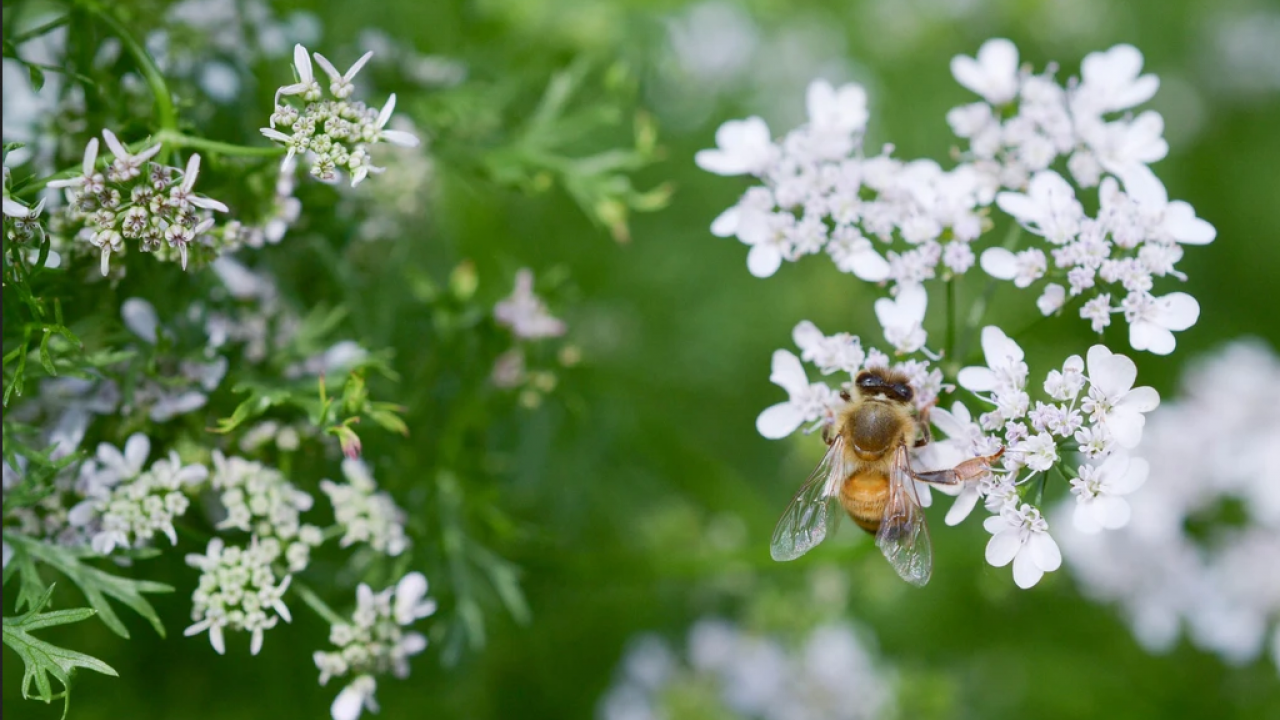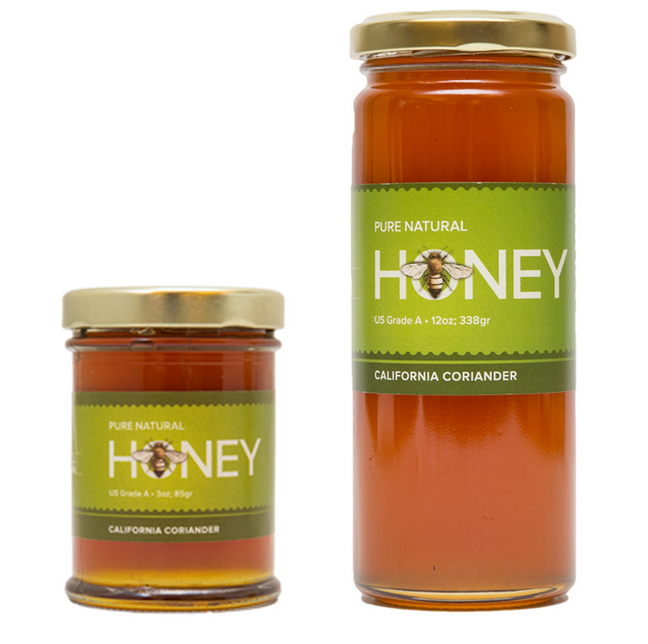
Coriander and Tomatoes
Coriander Honey is a unique and special treat. Its savory undertones are always a surprise. The complexity – a bit of cardamom, some licorice and a dark hint of chocolate are just so intriguing! How do you use a honey like this? It could make an interesting addition in a cocktail or as an ingredient in a barbeque sauce. Here at the Honey and Pollination Center, we tasted and tried Coriander honey to balance the acid in our summer’s tomato sauces and soups.
The luscious tomatoes that are growing on the vine in your back yard or that you just picked up at the farmer’s market are the beginning of summer’s bounty. Tomatoes have a long history in this part of the world. We associate this luscious fruit and all of its varieties with Italy, but in fact all tomatoes originated in the area now known as Central and South America. Tomatoes were introduced to the Spanish during the 1600’s. Spaniards took plants back to Europe and the rest is, shall we say, gastronomic history!
So how does a tomato get pollinated? Bumblebees use Buzz Pollination to shake pollen loose. For those of you who have grown this incredible vine, you have seen the simple yellow flower that eventually births a tomato. You might have noticed that the flower is pointed at the tip and closed. This means it is not welcoming for honey bees. The girls like the flower open with both pollen and nectar readily available at the sip of her proboscis, a straw-like tongue. Native bumble bees, on the other hand, are particularly adapted for pollinating the tomato. The bee flies up to the flower, attaching herself to it and vibrates her wing muscles creating a buzzing sound. As the flower is ‘buzzed’ the anthers open covering the bee in yellow green tomato pollen and creating the possibility of tomato fruit.
Watch this Buzz Pollination in action through DEEP LOOK, short video series created by KQED San Francisco.
If you cook a lot – and more and more of us are finding a fabulous outlet within our kitchen wall. You might be getting ready to make some tomato sauce to freeze or can for the winter and noticed that your recipe calls for sugar. Outside of being sweet, sugar has no character. This is the perfect place to add just the right honey to deepen the flavor of your sauce or soup. For tomato based products, try Coriander honey.
How to substitute honey: Simply - pay attention. Honey is much sweeter than sugar. If the recipe calls for a tablespoon of sugar, start with half that amount. Taste the sauce you are making and adjust as needed. Tomato based products can be much less sweet than those sold on supermarket shelves. You want to taste the tomatoes, the basil, the onions- not the sugar!
Another thing that can affect the amount of honey you might use is whether your tomatoes are canned or fresh. And if they are fresh – what variety are you using. This might sound like a lot to pay attention to, but the results will be worth it. San Marzano Roma tomatoes are usually available fresh at this time of year and they are so delicious! San Marzanos tend to be a bit sweeter than other Romas, so they need less honey to create the perfect balance.
And finally, you also need to know your honey. Tomato sauces and soups don’t need specialty orange blossom or lavender honey. The floral overtones will affect the flavor of the finished product. Instead, select a wonderful local wildflower or even a savory honey like coriander. Add the honey to the cooking pot, dissolve, taste, cook for a while so the flavors meld together, and then taste again. Let the flavor of the honey work with the tomatoes and all the seasonings before adding more. Taste again and decide if the flavor is right or if it is a bit too acidic. If so, add just a little more. Patience will yield the best flavor and you won’t regret it!
To learn more about coriander honey and other varietal honeys, take our virtual Honey Sensory Workshop on Thursday, October 22, 2020.
While it is still hot, try this outstanding Andalusian style Gazpacho. A chilled soup from Spain that, with the help of a blender, will only take about 15 minutes!
Andalusian Gazpacho Recipe

Ingredients:
- 2 ½ lbs of ripe tomatoes (if possible make sure about half of them are Romas, dense and sweet)
- 1 small cucumber (If you use a standard, garden variety cucumber, seed it. If you use English or Persian cucumber – don’t!)
- 1 medium red bell pepper, seeded
- ½ small red onion peeled
- 2 small garlic cloves (or 1 large clove), peeled
- 3 (or more) tablespoons good olive oil
- 2 tablespoons wine vinegar (if you have a sweet vinegar – sherry or fruit, use that)
- 1 teaspoon Coriander honey
- 1 teaspoon salt (go light – you can always add more later)
- ½ teaspoon freshly ground pepper
- ½ teaspoon cumin
- 1 thick slice of rustic bread – white or whole wheat – crusts removed
What to do:
Prepare your ingredients: Cut the tomatoes into smaller pieces. Cut away the hard stem end and remove any fibrous sections. If necessary, seed the cucumber and cut into 2 inch sections. Cut the red pepper removing the core and the seeds.
Purée:
In a blender (or a food processor) combine everything together for about a minute - except the bread.
Next: remove the top and slip the bread into the puree and let it sit for a couple minutes until it is fully soaked through. Put the top on and blend again until everything is thoroughly combined and smooth. Taste and adjust your seasoning. You might need more cumin, olive oil, pepper or – if the flavor is a bit sharp – some more honey.
Chill: It takes several hours to get the gazpacho to the right temperature
Serve cold and with an assortment of toppings: homemade croutons or cheesy bread, fresh basil, a drizzle of olive oil.

UCD Coriander Honey
Support The Honey and Pollination Center and get a bottle of this delicious honey for your pantry! Comes in two different sizes: 3oz and 9oz.

